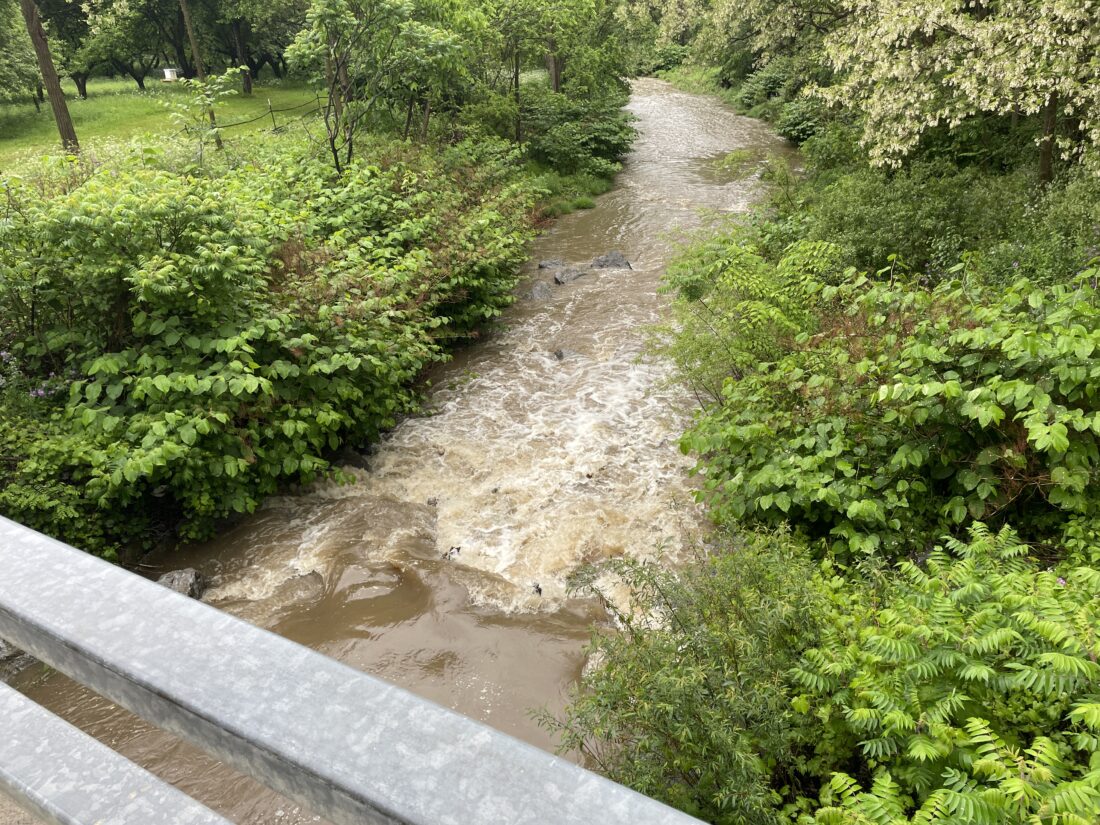Long-Term Health: Four Engineering Projects Wrap Up For Watershed

Bemus Creek runs under Meadow Drive following a storm. The creek is now the focus of a county-led, state grant-funded engineering survey to help with flooding and sediment issues. Photo by Jay Young
Lakeside communities continue taking steps on projects that will benefit the long-term health of Chautauqua Lake. This watershed work is often a years-long process that relies on grant dollars, and requires site engineering to identify viable projects. Programs like the state’s Non-Agricultural Nonpoint Source Planning Grant are designed to help local communities identify problems along streams and floodplains so that they can put shovels in the ground and improve water quality. By year’s end four alliance members will have completed state NPG engineering studies at key sites, allowing them to pursue larger grants to fund construction.
One of those sites is a section of Bemus Creek, which runs through the village of Bemus Point and the town of Ellery before entering the lake just below the I-86 bridge. Like many creeks around the area, Bemus can suffer from debris jams, sedimentation, flooding, and erosion issues. The Shore Acres community at the mouth of the creek in particular has had flooding issues in the past, and residents are eager for solutions. Colliers Engineering & Design is performing an engineering study for the lower section of the creek. These types of documents give a full accounting of creek conditions, and offer suggested projects that can be constructed to improve the creek and surrounding areas. Typically, engineering studies are used to construct stormwater projects that fight flooding, stabilize eroding streams, and build new features that help creeks flow more naturally.
The Bemus Creek grant, which was secured by the County, is one of four Alliance-partnered engineering projects finishing up this year. A similar assessment was recently completed on the lower section of Ball Creek for the Town of North Harmony by JM Davidson Engineering. Due to its location and issues related to erosion and debris jams, Ball Creek has received a lot of attention in recent years. A creek stabilization was also completed by the Town this year, and now this new engineering study will recommend future work in problem areas. In many cases, for streams to function properly, they require banks that are well-stabilized by native vegetation so that loads of sediment aren’t washed away during storms. In order to help fight against this, past projects done on Ball Creek have focused on plantings of species like willow trees that are very water-tolerant and help strengthen streambanks. Projects can also involve the removal of invasive on-land species like knotweed or tree of heaven.
The Village of Lakewood recently completed an engineering study for the drainage area around the Chautauqua Mall and Mall Boulevard, which has been prone to flooding. Rather than focusing on an individual section of a stream, this work looks at the existing stormwater infrastructure in a priority area, and suggests improvements related to new management features. The project engineers at EcoStrategies PLLC along with Village leadership have long advocated for addressing stormwater management near the Mall, and now those suggestions are ready to be acted upon.
Finally, the Town of Chautauqua completed engineering at a pair of culverts this summer as part of the NPG program. These two culverts located on Wright Road and Elmwood Road are in need of replacement for the sake of both water quality and roadway safety. EcoStrategies also took the lead on engineering for both of these sites, and has submitted cost-effective construction options to the town for consideration. With this engineering study in hand, the Alliance and Town quickly partnered on state grant applications for funds to install new culverts.
Partnerships form the core of successful long-term watershed work. Each project has to be identified, applied for, secured, bid out, administered, and completed–often over the course of several years. Matching local funds or in-kind work are also typically a requirement. The ongoing efforts of the County, the Soil and Water Conservation District, the Chautauqua Watershed Conservancy, and our lakeside municipalities are critical to the health of the lake. Thanks to all who have made these projects possible.
State funding for these projects was provided by the Environmental Protection Fund administered by the NYSDEC.



